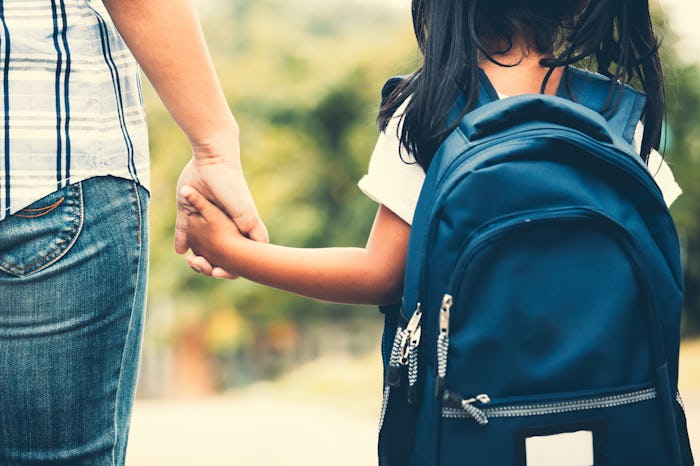Life

Can Coronavirus On Your Child's Backpack Cause Illness? Doctors Weigh In
Trying to stay safe from the coronavirus can mean taking a second look at everything you touch, including bags and accessories. And for parents who are sending their children to school for in-person learning, whether or not coronavirus can live on backpacks may be a big concern.
For the most part, experts are still studying the way coronavirus reacts to different surfaces, including the cloth and plastic material that make up a backpack. "It is possible that the coronavirus could live on a kid's backpack, or fabric item or article of clothing, for hours to days," as Shirin Peters, MD, the Founder, Medical Director, and Primary Care Physician at Bethany Medical Clinic of New York, tells Romper. But as far as the research is concerned, there isn't much definitive data yet.
"The main route of transmission for coronavirus is person to person; however, studies have shown that it can remain viable on cardboard for several hours and on plastic surfaces for up to 24 hours. There are no reliable studies on viral lifespan on material such as canvas, polyester or nylon — the most common materials for a backpack," Dr. Erika Schwartz M.D., author of Don’t Let Your Doctor Kill You, tells Romper.
So does this mean you can get coronavirus from your backpack? Technically, yes, but it's not likely. "Evidence suggests it's harder to catch the virus from a soft surface like a fabric than from a hard high-contact surface such as a doorknob," explains Dr. Peters. And even if a backpack does get covered in coronavirus with a sneeze or cough, for instance, this doesn't mean it will immediately make you sick. "The virus is not able to 'jump' off of a surface," Dr. Allison Messina, Chief of the Division of Infectious Disease at Johns Hopkins All Children's Hospital, tells Romper. "The way someone might get ill is from the act of touching a contaminated surface and then touching your mouth, nose or eyes. If hands are sanitized after touching a surface, this breaks the chain of transmission," she says. As with so many things related to coronavirus, keeping your hands clean is the key.
In fact, bags in general are not necessarily the biggest coronavirus threat. "A person is much less likely to contract coronavirus through contact with clothing or accessories than it is to be exposed to respiratory droplets infected with coronavirus by coming into close contact with a person with active infection," says Dr. Peters. Although there are plenty of myths about how coronavirus spreads, following social distancing guidelines and wearing a face mask are still among the best ways to help prevent it.
With this in mind, there's also some stuff you can do to keep yourself, as well as your backpack, away from the coronavirus as much as possible. "Placement in a personal locker or private contained area upon arrival at school, and then removal and storage of the backpack near the entrance of your home (with outerwear and shoes) can help keep the backpack sanitary," says Dr. Peters, who also suggests a weekly wash and (high-temperature) run through the dryer. "Wash your child's backpack more frequently, attach hand sanitizer to the strap or zipper and encourage use every time the backpack is opened or closed," advises Dr. Schwartz. In addition, tell your children not to share school supplies with other students and encourage them to maintain social distancing, even from their friends. It takes some vigilance, sure, but a little preventative care can make a big difference.
Experts:
Dr. Allison Messina, chief of infectious disease at Johns Hopkins All Children's Hospital
Shirin Peters, MD, board-certified internal medicine specialist; founder, medical director and primary care physician at Bethany Medical Clinic of New York
Dr. Erika Schwartz M.D. internist specializing in disease prevention, author of seven books including Don’t Let Your Doctor Kill You
This article was originally published on